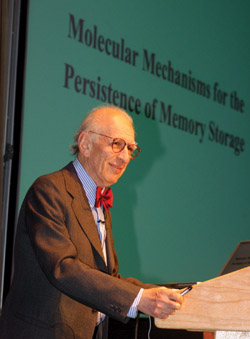
Dr. Eric Kandel. Photo by Dana Johnson
Nobel laureate describes role of prions in storing memory
Prions are self-propagating proteins associated with mad cow disease and variant Creutzfeldt-Jakob disease in humans. But they also may be important in long-term memory, Nobel Prize-winning memory expert Dr. Eric Kandel said Monday during a lecture at Vanderbilt University.
In the Dec. 30 issue of the journal Nature, Kandel and his colleagues reported that a nerve cell factor isolated from the giant marine snail Aplysia demonstrated prion-like properties when inserted in yeast cells — altering its shape and replicating itself.
If its self-propagating properties can be demonstrated in intact nerve cells —both in the snail and in higher animals, including humans —this protein may help explain how “you could alter certain specific synaptic connections in your brain without altering any others, and keep those going in perpetuity,” Kandel said.
Kandel, the University Professor of Physiology and Psychiatry at Columbia University, delivered the Second Eli Lilly Lectureship in Psychopharmacology in the Blair School of Music’s Ingram Hall.
Prion-like proteins are another piece of the puzzle of memory and learning that has fascinated Kandel for more than half a century. In the mid-1960s, he and his colleagues decided to study the marine snail because of its simple nervous system.
The researchers studied a simple defensive reflex — the withdrawal of the gill when the animal is touched or shocked. After a single stimulus, the animal can remember and respond strongly to a subsequent stimulus for a few minutes. But if the stimulus is repeated at least five times, the animal’s memory will last for days.
The researchers determined the molecular mechanisms that distinguish short-term from long-term memory. They found that to establish long-term memory, genes in the nerve cell nucleus must be activated to encode for proteins involved in the growth of new synaptic connections.
One of the factors in this process is a prion-like protein, CREB-1. When switched to its prion-like form, it can stimulate translation of protein for new synaptic connections, and it can amplify this activity through self-propagation.
The discovery, Kandel said, “has caused us to think that perhaps our definition of prion protein in the past been too restrictive.”













